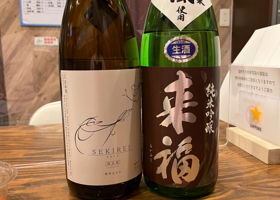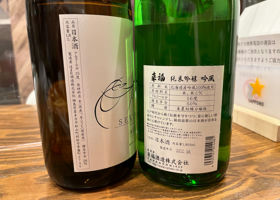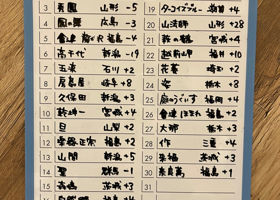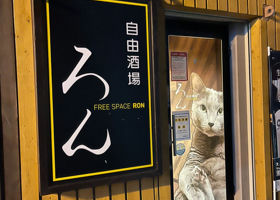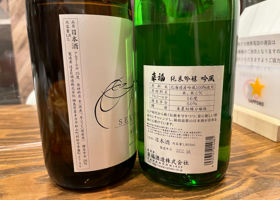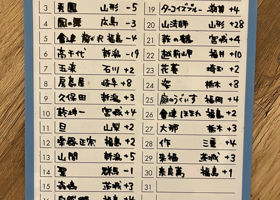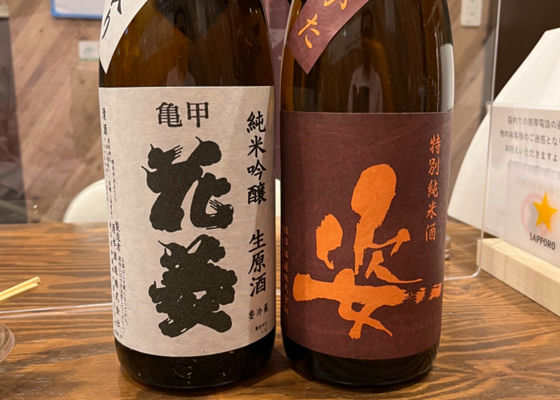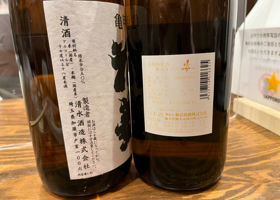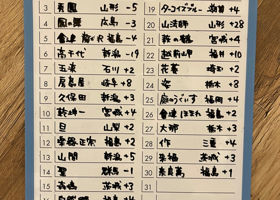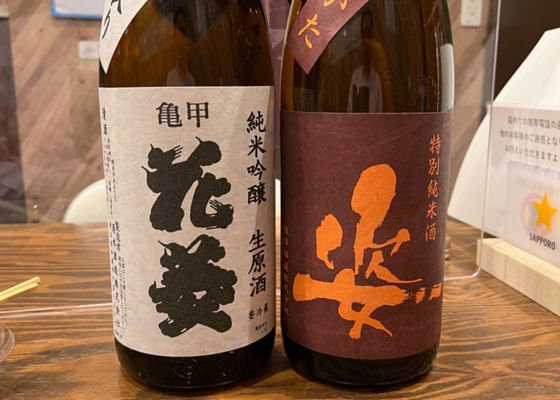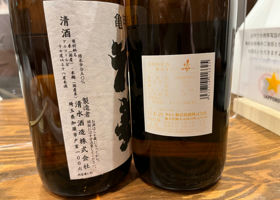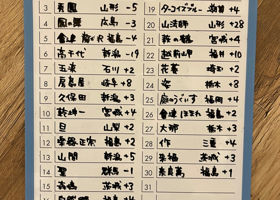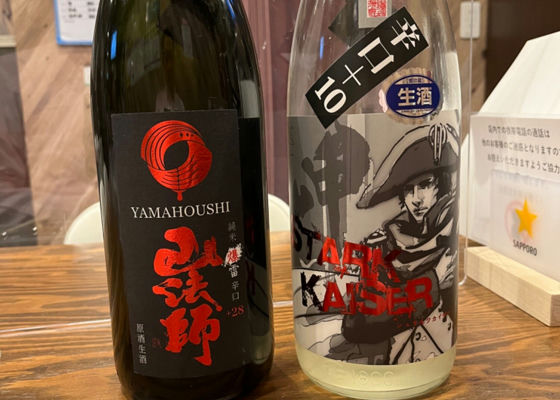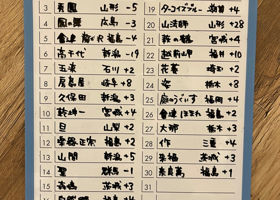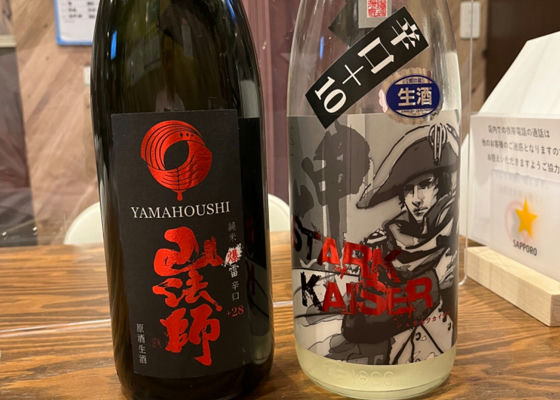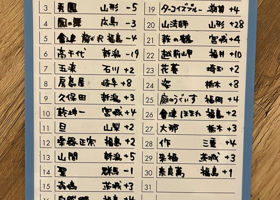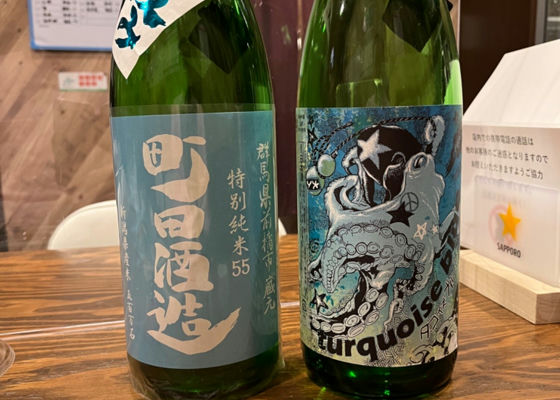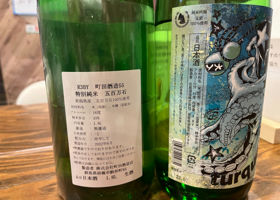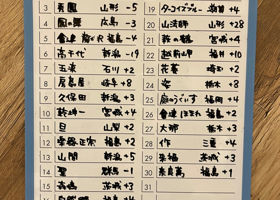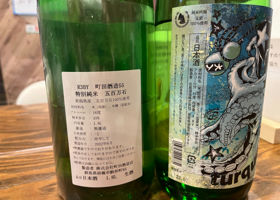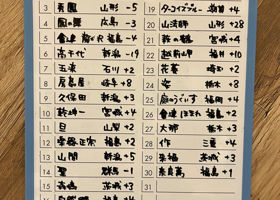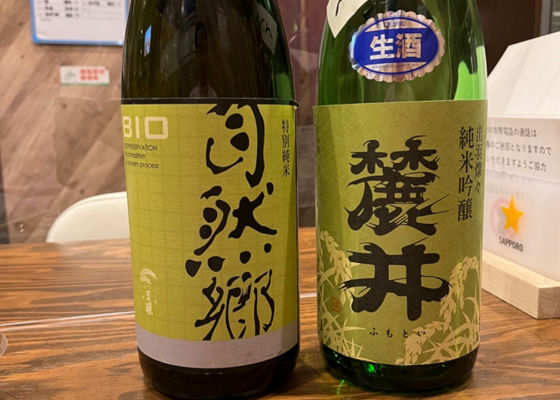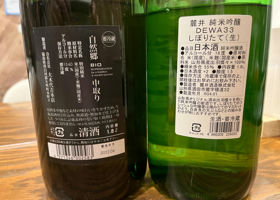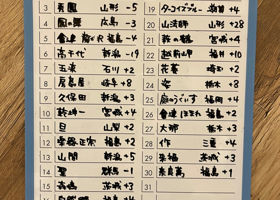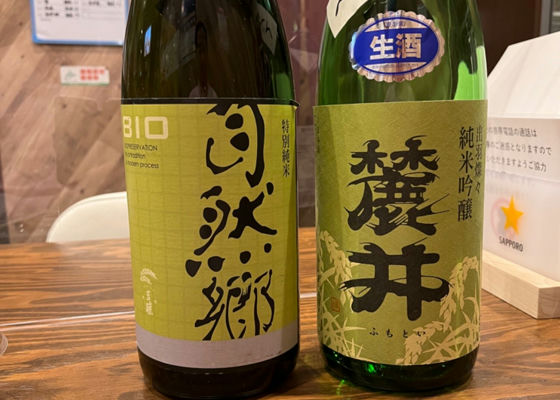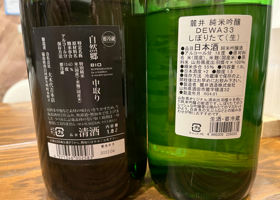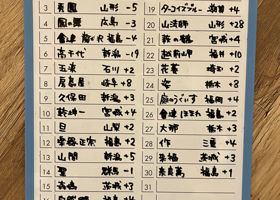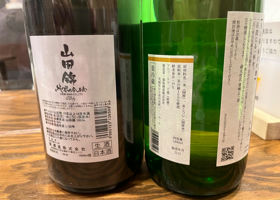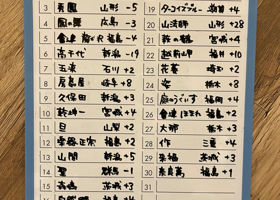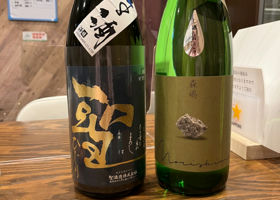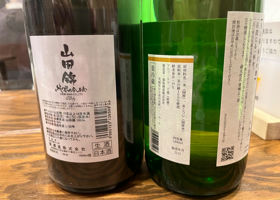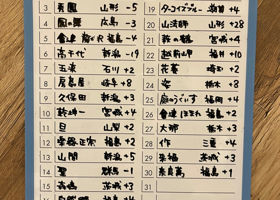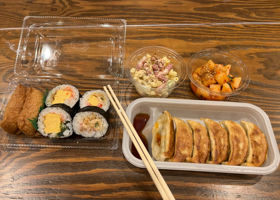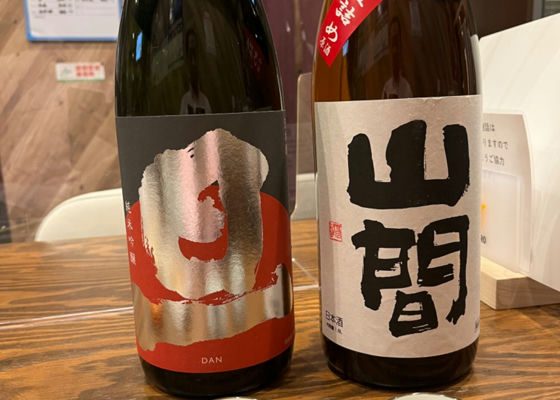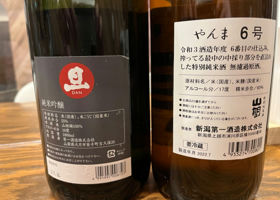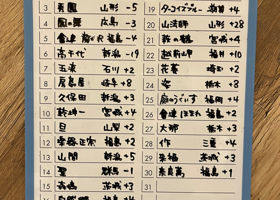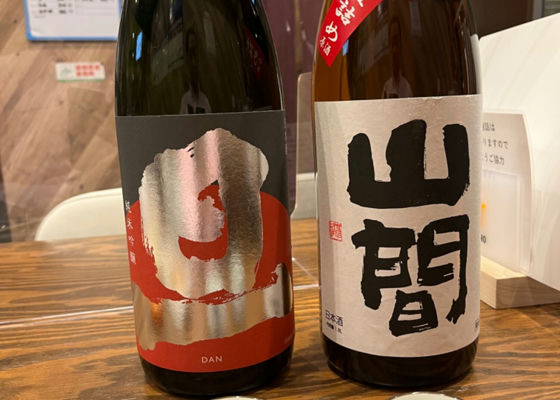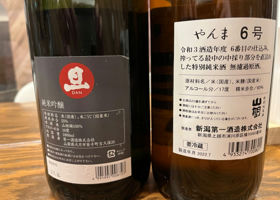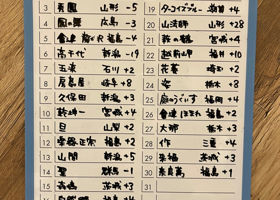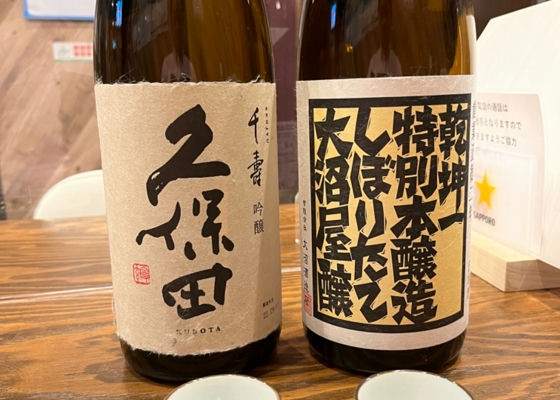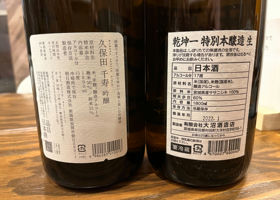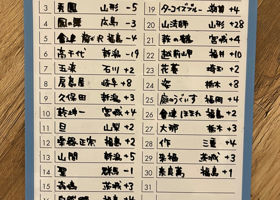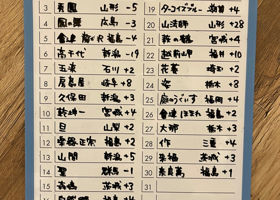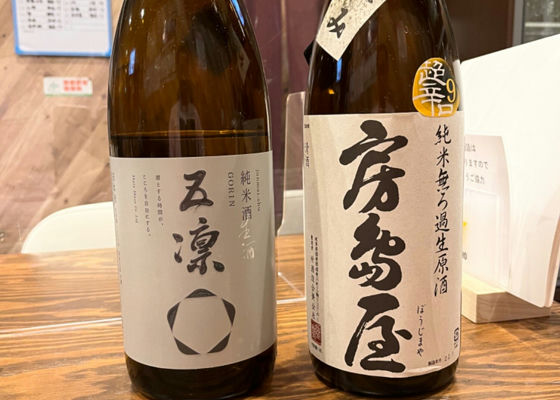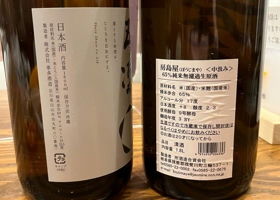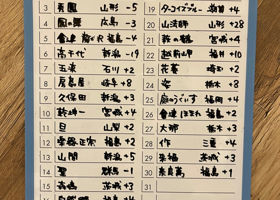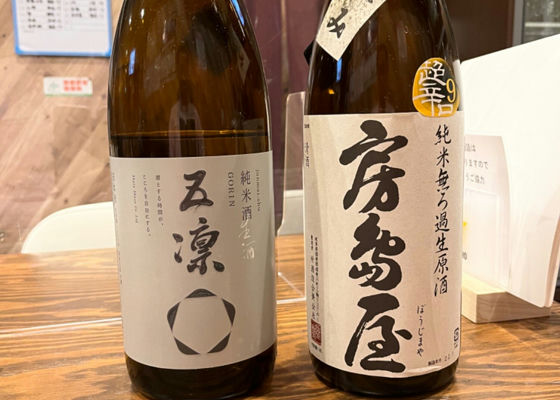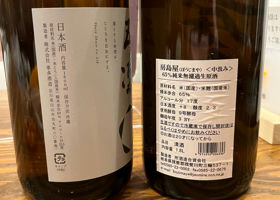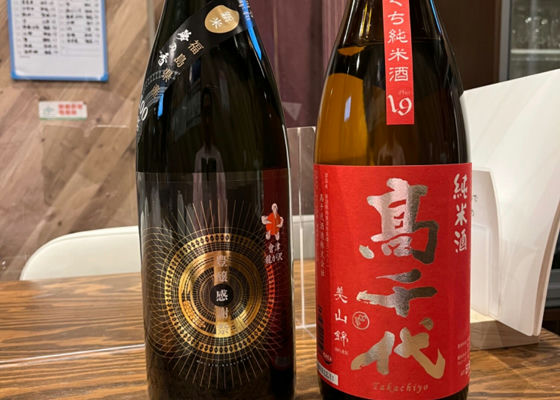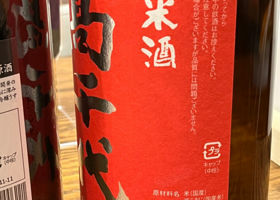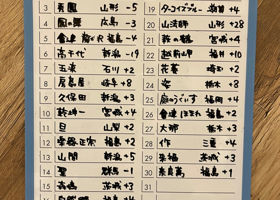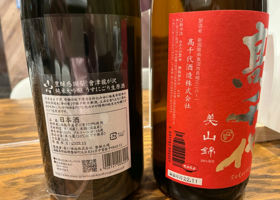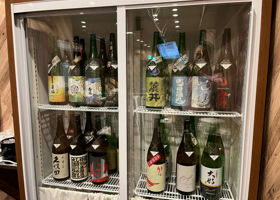Timeline
しんしんSYI still give the nod to Raifuku.
It was a fresh fruity and delicious end to a delicious drink!
I usually come to Kushiro on Mondays, and I wanted to visit this restaurant, so I decided to come on Thursday this time!
500 yen discount for LINE friends!
The price of drinks was 1500 yen!
After all, it was a private party!
It was a good place where you can drink at your own pace and relax, so I would like to come back again!
extensive knowledge
Raifuku Brewery, a pioneer of flower yeast
This junmai ginjo uses "Ginpu" rice, which has been used by various breweries in recent years as a good rice for sake brewing in Hokkaido.
The use of sunflower flower yeast gives this junmai ginjo a gorgeous aroma with sweetness and a good balance of umami with a good degree of fullness. The finish is fresh and juicy with good sharpness. 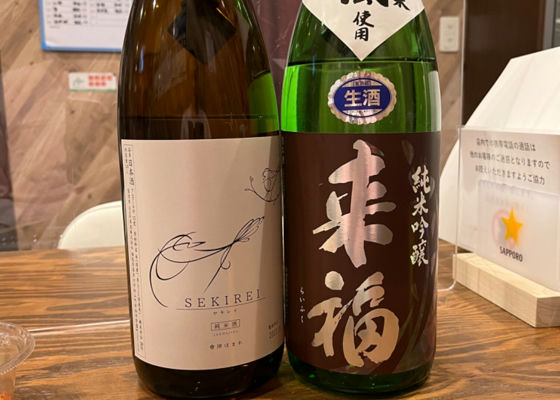
しんしんSYAs time was getting close to running out, we compared two Aulas drinks
This is also a first for me!
extensive knowledge
Two wagtails are delicately drawn with a line drawing touch on the elegant pearlescent label. The wagtail is the city bird of Kitakata City. For Kitakata residents, it is a familiar bird with a long tail that can be seen in the city. One bird looks back and waits for its companion while moving forward. The other bird follows the companion ahead of it. These birds are said to represent the brewery moving forward little by little as one.
The rice used for the sake is "Hanabukiyuki" produced in Fukushima Prefecture. The yeast used is an original yeast called "Utsukushima Yume Yeast," the first of its kind in Fukushima Prefecture. The taste is crisp and tight, with a mild mouthfeel. The fruity and refreshing aroma spreads on the palate. The taste is fresh and youthful, as if it were freshly pressed. It has a clean aftertaste, and although it is dry, its low acidity makes it very easy to drink and to match with food. しんしんSYI felt that I couldn't drink all of them if I drank them in order.
I skipped a few and limited myself to the brands I was interested in.
Hanabishi for the winners!
extensive knowledge
SAGATA Zare-Sugata Special Junmai Sake is an ultra-dry special junmai sake made with Yamada-Nishiki. Unlike the usual "Sugata" flavor, which is mellow and gorgeously sweet, this sake has a clean, sweet taste. It also has a sense of transparency, and the beautifully clean aftertaste will keep you sipping. The softness and moderate fruitiness spread out in the mouth. There is also an acidity with a sense of unity and a calmness that can only be achieved by fire-roasting.
Sake meter rating +8
Acidity 1.8
Rice: Yamadanishiki
Polishing ratio 60 亀甲花菱純米吟醸生原酒無濾過中取り美山錦純米吟醸原酒生酒中取り無濾過 しんしんSYIt was a fruity drink.
Time is almost up!
We drank about 2/3 of a cup!
The waiter told me that I was almost finished!
Knowledge
It has a gentle aroma of peach-like fruit. In the mouth, it has a heavy sweetness and umami flavor, and it finishes with a touch of astringency. It is recommended for those who like fruit aroma and sweet sake.
Rice used: Miyamanishiki
Rice polishing ratio: 50
Alcohol content: 17.0 しんしんSYThis is another label I'm interested in
Both are dry.
But I'm going to go with Echizenmisaki for the first time.
I'm going to Hokuriku via Komatsu Airport at the beginning of the year!
I want to enjoy Hokuriku sake 🍶.
knowledge
stark kaiser. German for "powerful emperor.
It combines roughness and power with a soft and crisp taste.
Rice: Yamadanishiki produced in Hyogo Prefecture
Rice polishing ratio: 60
Alcohol content: 17
Sake degree: +10
Acidity: 1.6
Yeast used: Association No. 601 しんしんSYThe hottest one of the night
+28
But it wasn't that hot.
It's a good balance of hot and cold.
extensive knowledge
An extra item in the Yamaboshi series! Junmai "Bakurai Dry Taste" Nama-no-Mazake
This junmai sake has a taste that is completely opposite to the soft taste that is the concept of Yamaboshi. Using a special yeast, the rice polishing ratio is kept low to preserve the umami flavor, yet the taste is super dry. It is a gem with a crisp rice flavor that spreads in the mouth, followed by a punchy spiciness. The aroma is similar to that of grapefruit, making it the hottest sake in Japan and worthy of being an out-of-the-box item.
Rice: 100% Dewanosato (produced in Yamagata Prefecture)
Refining ratio: 70%.
Fermentation: Yamagata yeast
Sake meter rating: +28
Acidity: 1.3
Amino acidity: 1.2
ALC: 18 degrees Kitajimaきたじま 純米吟醸 Turquoise Blue タコイズブルー純米吟醸 しんしんSYUnusual label
I was curious about the octopus.
I'll give it to Octopus.
extensive knowledge
Kitajima is a limited distribution brand of Kitajima Shuzo, which brews "Miyosakae Miyosakae" in Shiga Prefecture. This is Kitajima's limited series with an eye-catching, unique label. With its turquoise-like coloring and green bottle, it appears as a cool-looking summer sake. It is juicy on the palate, with a lush fruity aroma and a refreshingly dry sharpness that blows away the sultry heat. The green apple-like fruit aroma is refreshing and crystal clear.
Rice used: Tamakae
Rice polishing ratio: 55
Sake meter rating: +10
Acidity: 1.7
Yeast・・・No.7 yeast
Alcohol content・・・15
しんしんSYPale blue label showdown
Ihyakumangoku is the third time
knowledge of how to make the best use of
Fresh & Fruity♪
The balance between the sweetness of the rice and the fresh acidity is in good condition.
Rice used: Gohyakumangoku
Rice polishing ratio: 55
Sake degree: -1
Alcohol degree: 16
Ingredients: Rice, Rice malt
Yeast: Association 1801 + Gunma KAZE yeast Fumotoi(ふもとい) きもと純米吟醸 出羽燦々 しぼりたて生純米吟醸生酛生酒 しんしんSYFudai after a long time
I'll give the edge to Shizenkou.
extensive knowledge
Everything is made from Yamagata Prefecture's sake brewing rice "Dewa Sanzu" and Yamagata yeast. Its soft and pleasant taste makes it an excellent match for any food.
Ingredients : Dewasanbara
Rice polishing ratio : 55
Sake meter : +2
Acidity : 1.5
Alul. content : 16 しんしんSYI've never had a Shizenkogo either.
Tonight I am enjoying many brands that I have never had before!
Since we had 2 hours of all-you-can-drink, I had to pick up the pace to finish all 30 brands!
I learned recently that Gakki is out of stock, so I'll have 29 kinds tonight!
Come on, let's have some more fun!
a little more knowledge
This is a special junmai sake brewed with a raw yeast yeast sake mother grown using our proprietary method. It is characterized by a good balance of sharp sweetness and umami that spreads to the back of the mouth, and acidity derived from the action of lactic acid bacteria. Of the sake that flows out after pressing, only the middle portion (Nakadori), which is said to have a well-balanced flavor, is selected for bottling.
Rice used
Yumenokou" from Fukushima Prefecture
Rice polishing ratio
60% (60%)
Alcohol content
15 degrees Celsius 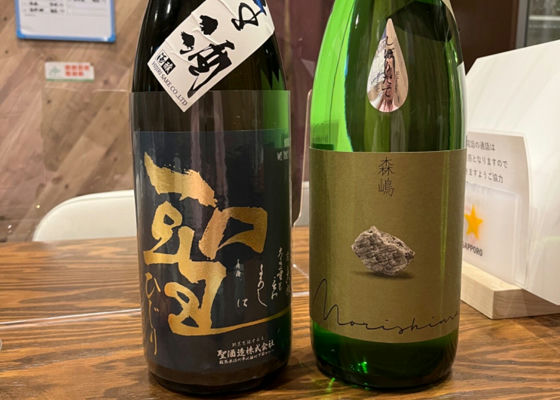
しんしんSYI had a hard time deciding, but I decided to go with St. John's.
Both are delicious!
It's my favorite.
extensive knowledge
Morishima is a limited distribution brand from the Morishima Sake Brewery in Ibaraki Prefecture.
It will be renewed from 2019 (2019 brewing year) from the existing brand "Taikan". After about 10 years since its conception, the brand was named after its own gender, "Morishima," to express the passion and determination that the brewer has for sake making. The brewer himself is now taking on more responsibility than ever before to brew delicious sake for everyone, and has taken the brand to a new level by evolving the "lightness" and "freshness" of the sake to its fullest extent.
It has a mild aroma reminiscent of green apples, and a fresh taste with a cool, clean flavor.
The acidity in the back of the mouth is pleasant, making it a refreshing and enjoyable chilled sake. The label features a design of the Oyaishi stone from the stone warehouse that actually collapsed in the Great East Japan Earthquake, expressing our indomitable spirit to continue brewing sake and our desire to keep a stone's throw to ourselves in the future.
Rice used: Miyamanishiki
Rice polishing ratio: 55
Sake meter rating: +2
Acidity: 1.8
Alcohol content・・・15 Hijiri(ひじり)純米吟醸 山田錦 無濾過生酒純米吟醸原酒生酒無濾過 しんしんSY2100 in passing.
I have visited the brewery before and have a sense of familiarity with this sake 🍶.
Dark blue label with gold letters
It's still delicious!
Hizyrism is delicious, but Kanji no Sei is delicious too♪
knowledge of the brewery's history
Hijiri Junmai Ginjo Yamadanishiki Unfiltered Nama-Shu is a seasonal sake made from authentic Hyogo Prefecture Yamadanishiki.
The sake is freshly pressed in a refrigerated room and bottled unfiltered and unpasteurized.
It uses a yeast called M310.
M310 yeast is a mutation of the Akari Ogawa yeast (Association No. 10) developed by Chikara Ogawa of Akari Sake Brewery and produces more ethyl caproate.
Sake degree +1
Acidity 1.5
Rice: Yamadanishiki (Hyogo Prefecture)
Polishing ratio 50%.
Yeast used: M-310 yeast 山間 六号特別純米 仕込み6号 中採り直詰め 無濾過原酒特別純米原酒生酒中取り無濾過 しんしんSYI'm still going with the mountains.
extensive knowledge
The brewer comments, "It was quite aromatic and had a rich, dark flavor when pressed." It has a juicy, full flavor that is not typical of special junmai. The sake is brewed with locally grown rice in Yamama, with no compromise allowed, and is named "Yamama" (meaning "between the mountains" in Japanese) only for the sake that is unfiltered and unfiltered.
Rice : Takane-Nishiki
Rice polishing ratio : 60
Alcohol content : 17 しんしんSYSake from Yamanashi that I haven't had much of yet.
extensive knowledge
Mr. Masakazu Ito, who was recommended by Mr. Naohiko Noguchi, one of the Four Heavenly Kings of Noto Toji, to join "Sasaichi Sake Brewery", has been attracting a lot of attention.
Yamahai" is synonymous with "Tadashi," but "Hayazai" is also very popular. Junmai Ginjo is made with Yamadanishiki for both koji rice and kake rice, and the rice polishing ratio is 55%. The Junmai Ginjo is made entirely from Yamadanishiki, making it an inevitably very popular sake. Junmai Ginjo has a very refreshing aroma with a hint of melon. Behind the refreshing aroma, there is also a full-bodied aroma. When you drink it, you can feel the softness of the water and the umami of the rice, and although it has a strong taste, it is clean and gentle, and the acidity leads you to a beautiful aftertaste. しんしんSYI give the nod to Kubota.
extensive knowledge
Unlike our regular Honjozo, we use Miyagi B yeast.
It has a fruity, gorgeous and fresh taste. It is a limited edition product available only during the current season.
Rice used: Sasanishiki
Rice polishing ratio : 60
Alcohol content : 17 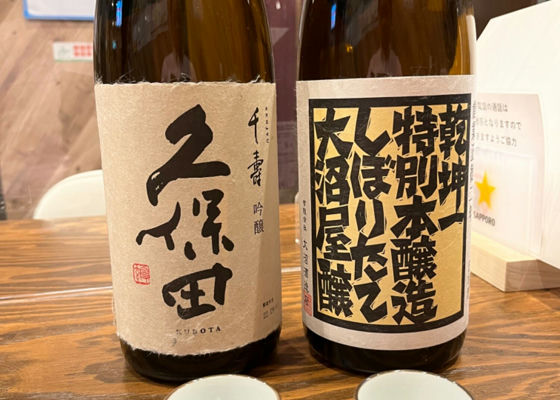
しんしんSYFirst time for Kubota Senju
Aruzoe confrontation
No miscellaneous taste
It was a delicious sake with a light, almost watery taste.
extensive knowledge
Kubota Senju" is the very origin of Kubota, first created in 1985 when Kubota was launched. Seeing the shift in the foundation of labor for Japanese people living in urban areas from physical labor to intellectual labor, the company aspired to create a "light and dry" sake. By making fundamental improvements to the sake brewing process, Kubota achieved a clean, light, dry, yet mellow taste that was not for everyone at that time. Thirty-five years have passed since then. In keeping with the times, we pursued a more "refreshing taste that goes well with meals. We have made sure that the fermentation process is highly precise at low temperatures, and have increased the refreshing taste with less cloying flavors. We also maximized the effects of koji to create a wide range of flavors while maintaining the clean, refreshing, and light taste.
Rice (Polishing ratio)Koji rice / Kake rice: 50% Gohyakumangoku / 55% Gohyakumangoku
Alcohol content 15.0
Sake meter degree +5.0
Acidity 1.1 しんしんSYJunmai Sake Unfiltered Nama-shu Showdown
Fusashimaya wins
extensive knowledge
Brewed to be enjoyed with food, this is Fusashimaya's standard sake. A robust umami flavor that is very drinkable. The rich acidity gives it a sharpness. When heated, it has a clean, refreshing taste that enhances the flavor and richness of the food. The dynamic flavor of this unfiltered, unfiltered sake is a perfect match for Chinese and other richly flavored dishes and rich cheeses.
Brief Sketches
Ingredients: Rice (domestic), rice malt (domestic)
Rice used Domestic rice
Rice polishing ratio 65
Alcohol content 17
Sake degree +8
Acidity 2.3
Yeast: Association No. 9 しんしんSYextensive knowledge
It was named "Gorin" so that the five parties - customers, restaurants, sake retailers, brewer, and toji - can always enjoy the taste of sake in a dignified relationship. Junmai-shu made from carefully polished Yamada-Nishiki rice. It has a soft throat sensation. Fresh aroma unique to nama-shu. Light but rich in flavor, this junmai sake has a well-balanced taste. The refreshing acidity finishes off the palate and keeps the sake flowing.
Ingredients : Rice, Rice malt
Alcohol Content: 15.5%.
Sake meter rating: +3
Acidity: 1.7
Rice type:Yamadanishiki
Rice polishing ratio:60
Condition: Nama-shu しんしんSYThe winner goes to Aizu.
The menu list says "-19".
I thought it was sweet, but it was quite spicy!
I checked later and this sake was +19!
No wonder it's hot!
Knowledge
This sake is brewed with super soft water from the melted snow of Mt. Takachiyo" is brewed by flattening and polishing rice in their own rice polishing machine, which takes twice as long as usual.
It is fully fermented and super dry, and even though it is numerically quite dry at +19, it is strangely soft on the palate. It has a light richness on the nose, a dry texture from the mid-palate, and a crisp spiciness from the latter half.
Ingredients: Rice, rice malt
Ingredients: Miyamanishiki
Polishing ratio: 65% flat polished rice
Alcohol percentage 16-17
Sake degree +19
Acidity 1.5
Aizu會津龍が沢 純米大吟醸 無ろ過うすにごり生原酒 豊醸感謝祭 ヌーヴォー<新酒>R4BY純米大吟醸原酒生酒無濾過にごり酒 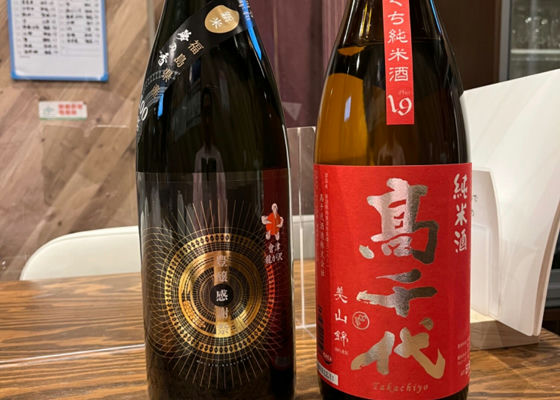
しんしんSYextensive knowledge
Underground water from Bandai, one of the 100 best waters in Japan, is used for brewing.
This Junmai Daiginjo-shu is brewed with "Yume no Kaori," a sake brewing rice developed by Fukushima Prefecture. It has a gentle ginjo aroma, sweet rice flavor, and a full-bodied, robust taste. This unfiltered, lightly nigori raw sake has a freshness that only new sake can have, and is exquisitely accented with a touch of lees. You can fully enjoy the blessings of the famous Aizu Bandai Mountain.
Ingredients: Rice (domestic), rice malt (domestic)
Rice used: Yumenokou (Fukushima Prefecture)
Rice polishing ratio 50%.
Alcohol content 16.0
Sake degree -1.0
Acidity 1.5
Yeast: Utsukushima Kirameki yeast えりりんShin-san konban-ha (Translated by.
From Koro-chan 🎁.
It was very delicious 😋.
しんしんSYGood morning, Eririn 😃It looks like we drank the same one around the same time. I didn't realize it was Korori🎁 at first, but I have seen that black bottle somewhere before. It was delicious. RecommendedContentsSectionView.title
